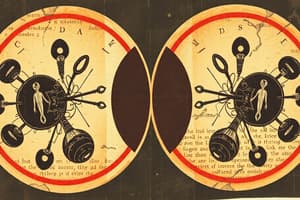Podcast
Questions and Answers
DNA sequences that control traits are called:
DNA sequences that control traits are called:
- Genes (correct)
- Enzymes
- Proteins
- Characteristics
Meiosis produces two identical diploid daughter cells.
Meiosis produces two identical diploid daughter cells.
False (B)
What process creates identical daughter cells?
What process creates identical daughter cells?
Mitosis
During the S phase, DNA is __________.
During the S phase, DNA is __________.
Match the following processes with their outcomes:
Match the following processes with their outcomes:
What type of cells does mitosis produce?
What type of cells does mitosis produce?
Meiosis results in two diploid cells.
Meiosis results in two diploid cells.
What is the chromosome number for humans?
What is the chromosome number for humans?
During the cell cycle, a cell spends most of its time in ________.
During the cell cycle, a cell spends most of its time in ________.
Match the phases of cellular division to their description:
Match the phases of cellular division to their description:
What happens to the nuclear membrane during prometaphase?
What happens to the nuclear membrane during prometaphase?
Metaphase accounts for approximately 4% of the duration of the cell cycle.
Metaphase accounts for approximately 4% of the duration of the cell cycle.
What structure forms on chromosomes during prometaphase that is essential for their movement?
What structure forms on chromosomes during prometaphase that is essential for their movement?
In prophase, chromatin condenses and the __________ disappears.
In prophase, chromatin condenses and the __________ disappears.
Match the phase of mitosis with its main characteristic:
Match the phase of mitosis with its main characteristic:
What process forms the nuclear membranes during cell division?
What process forms the nuclear membranes during cell division?
Meiosis I produces daughter cells with a haploid amount of DNA.
Meiosis I produces daughter cells with a haploid amount of DNA.
What is the period between telophase I of meiosis I and prophase II of meiosis II called?
What is the period between telophase I of meiosis I and prophase II of meiosis II called?
During Meiosis II, the division that occurs is referred to as _____ division, similar to mitosis.
During Meiosis II, the division that occurs is referred to as _____ division, similar to mitosis.
Match the following stages of meiosis with their descriptions:
Match the following stages of meiosis with their descriptions:
Flashcards
Meiosis
Meiosis
A type of cell division that produces the male and female sex cells.
Mitosis
Mitosis
Cell division that creates two identical daughter cells.
Genes
Genes
DNA segments that control traits.
Human body chromosomes
Human body chromosomes
Signup and view all the flashcards
Human sex cell chromosomes
Human sex cell chromosomes
Signup and view all the flashcards
Prophase
Prophase
Signup and view all the flashcards
Prometaphase
Prometaphase
Signup and view all the flashcards
Metaphase
Metaphase
Signup and view all the flashcards
Anaphase
Anaphase
Signup and view all the flashcards
Telophase
Telophase
Signup and view all the flashcards
Centrioles in opposite poles
Centrioles in opposite poles
Signup and view all the flashcards
Chromosomes in mitosis vs meiosis
Chromosomes in mitosis vs meiosis
Signup and view all the flashcards
What is a cell cycle?
What is a cell cycle?
Signup and view all the flashcards
What is mitosis?
What is mitosis?
Signup and view all the flashcards
Why are chromosomes halved in sex cells?
Why are chromosomes halved in sex cells?
Signup and view all the flashcards
What happens during cytokinesis in meiosis I?
What happens during cytokinesis in meiosis I?
Signup and view all the flashcards
What is Interkinesis?
What is Interkinesis?
Signup and view all the flashcards
What happens during Karyokinesis II?
What happens during Karyokinesis II?
Signup and view all the flashcards
What are the stages of Meiosis II?
What are the stages of Meiosis II?
Signup and view all the flashcards
What characterizes Prophase II?
What characterizes Prophase II?
Signup and view all the flashcards
Study Notes
General Biology 1 - Mitosis/Meiosis
- Mitosis/Meiosis: Describes the stages of cell division, specifically mitosis and meiosis, in a 2n=6 scenario. Focuses on the processes and outcomes in these two types of cell division.
Mitosis
-
Definition: A type of cell division that produces two genetically identical daughter cells, with the same number of chromosomes as the parent cell. It is a fundamental process for growth, repair, and asexual reproduction.
-
Phases:
- Prophase: Chromatin condenses into chromosomes, and the nuclear membrane breaks down. The centrioles move to opposite poles, and spindle fibers form.
- Prometaphase: Microtubules attach to kinetochores on the chromosomes, beginning their movement.
- Metaphase: Chromosomes line up along the metaphase plate or equator of the cell, with sister chromatids attached.
- Anaphase: Sister chromatids separate from each other at the centromere and move towards opposite poles of the cell.
- Telophase: Chromosomes arrive at opposite poles, unpack into chromatin, and the nuclear membrane reforms. The cytoplasm divides (cytokinesis) leading to two separate daughter cells.
-
Purpose: Growth and repair of tissues and organisms. Producing identical copies of the parent cell, crucial for cell replacement.
Meiosis
-
Definition: A type of cell division that results in four genetically different daughter cells, each with half the number of chromosomes as the parent cell. Key for sexual reproduction and genetic variation.
-
Stages (Meiosis I):
- Interphase: DNA replication occurs.
- Prophase I: Homologous chromosomes pair up, crossing over occurs, and the nuclear membrane breaks down.
- Metaphase I: Paired homologous chromosomes line up along the metaphase plate.
- Anaphase I: Homologous chromosomes separate and move to opposite poles.
- Telophase I: Chromosomes arrive at opposite poles, the nuclear membrane may reform, and cytokinesis occurs to create two haploid daughter cells.
-
Stages (Meiosis II):
- Interphase: No DNA replication occurs between meiosis I and meiosis II.
- Prophase II: Chromosomes condense, the nuclear membrane breaks down, and spindle fibers form.
- Metaphase II: Chromosomes line up along the metaphase plate (single file instead of paired).
- Anaphase II: Sister chromatids separate and move to opposite poles.
- Telophase II: Chromosomes arrive at the poles, the nuclear membrane reforms, and cytokinesis occurs to create four haploid daughter cells.
-
Purpose: Producing gametes (sperm and egg) with half the chromosome number for sexual reproduction. Generating genetic variability via crossing over, crucial for evolution.
Additional Information
- Chromosome Number: The complete set of chromosomes found in a somatic cell. Humans have 46 chromosomes (23 pairs).
- Genome: All the genetic information in an organism.
- Gene: A segment of DNA that codes for a specific protein or trait.
Studying That Suits You
Use AI to generate personalized quizzes and flashcards to suit your learning preferences.





